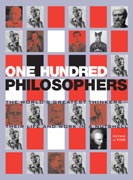| Philosophers: | Adi Śańkara |
| also known as Śakarācārya, Shankara, Śamkara (c.788-c.820 CE) |
|
| [Life & work] | [On-line introductions] | [On-line texts] |
|---|
| LIFE & WORK |
|
Little is known about Śańkara's early life, though there are the usual culture-hero accounts of his birth and childhood exploits. Like Nāgārjuna, he was born into a Brahmin family (probably in about 788 CE in Kaladi, Kerala) and, in common with a surprising number of the philosophers in this volume, his father died when he was young. He was a pupil of Govindapāda, who in turn had been a pupil of Gaudapāda; it was Gaudapāda who, in approaching Vedānta Hinduism against a background of Buddhist thought had first introduced the advaita (non-dualist) position that Śańkara established as a major Hindu philosophical school. Śańkara's life was short (about thirty-two years), but he's said to have produced a very large number of writings; he also travelled all over India, debating with Hindu and Buddhist thinkers and religious leaders, and founding Hindu monasteries. His place and manner of death is as obscure as his birth, surrounded by as many conflicting accounts; he seems, though, to have died in about 820 CE in Kedarnath in the Himalayas. At the heart of Śańkara's system is his rejection of two important 'orthodox' (astika) schools of Hindu philosophy: Vaiśeşika, founded by Kanāda in the second century BCE, and Sāmkhya, whose earliest text is the late-fourth-century CE Sāmkhya Kārikā, but which had existed since the seventh century BCE. The former holds that there are seven padārthas (categories of being), some material, some immaterial, each padārtha being further subdivided into basic components of the world like atoms. The latter is dualistic, distinguishing between two kinds of being: puruşas ('knowers'; individuals, whose essence is consciousness) and prakti (non-conscious 'nature' or 'matter'). Śańkara accepts that the world appears to be dualistic, but argues that this simply an appearance, for everything is in fact Brahman. Brahman is a difficult concept, and can be compared (but certainly not identified) with Heraclitus' logos, Lao-zi's dao, Plotinus' One, and Spinoza's Substance; it's the unchanging, indivisible, eternal reality, which we experience in terms of time and space, plurality and change. Experience (and inference from experience), then, can give us no knowledge of Brahman, although we each have some direct awareness of it, for we each have direct awareness of our own consciousness, which is identical with Brahman. For understanding we need to go the Upanişads, which embody the result of philosophical (not religious) meditation, and which demand similar meditation from us. Genuine knowledge of Brahman comes in our understanding that we are in fact simply part of it, not genuine individuals. Śańkara is often presented as the Hindu Kant. If such comparisons are useful at all (rather than inherently misleading, as seems more likely) his system would be better compared with that of Parmenides, who argued that we can know the unperceived world-as-it-really-is, just as Śańkara stressed that we can have knowledge of Brahman. Kant, on the other hand, held the noumenal world to be necessarily unknowable. Śańkara's advaita (non-dualist) vedāntic Hinduism became the most influential of all Hindu philosophical schools. |
| WEB PAGES & INTRODUCTIONS |
| ON-LINE TEXTS |
|
|
|
|  Intro. Page Intro. Page
|  Philosophy Philosophy
|  Everything Else Everything Else
|
 One Hundred Philosophers
(2004)
One Hundred Philosophers
(2004)
